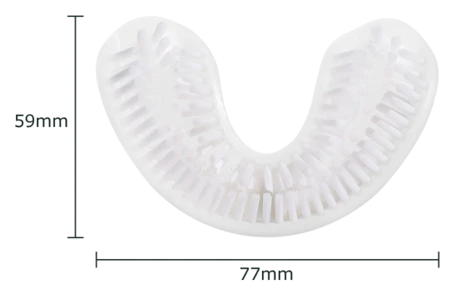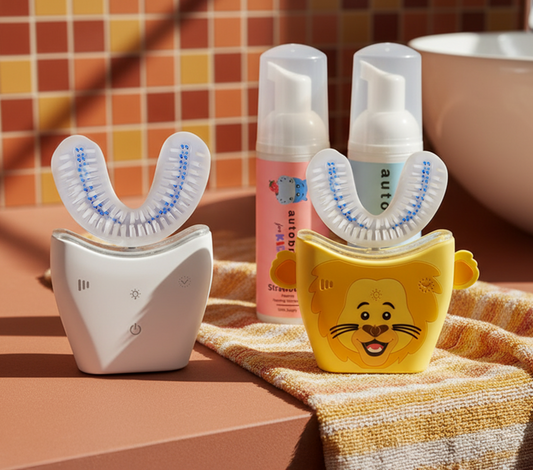
What is Nano-Hydroxyapatite & Why is it Used in Toothpaste?
If you ever asked your dentist about which toothpaste to use, you've probably heard them speak highly of fluoride toothpaste and varnishes. Fluoride products have enjoyed a long, unchallenged reign in the field of dentistry... until now.
A newer material has surfaced and is challenging fluoride’s authority: Nano-hydroxyapatite.
While the name nano-hydroxyapatite (nHA) may seem like one taken from a chemistry textbook, don’t let its long name scare you.
In this article, I will discuss key questions like what is nano-hydroxyapatite, how it's made strides in the dental industry, and why it is beneficial to your oral health.

What is Hydroxyapatite?
According to NewMouth, Hydroxyapatite (HA) is a calcium-based mineral having a chemical formula Ca5(PO43)OH2.
HA is actually a primary component of our bones and teeth. It makes up over 97% of the tooth’s outer enamel layer and around 70% of the inner dentine! HA, along with other minerals, makes our teeth and bones strong and prevents them from damage.
How Does Hydroxyapatite Help Our Teeth?
Besides giving our teeth a pleasant and shiny appearance, HA also prevents our teeth from decay and softening. Healthy teeth contain an abundance of HA. When the oral pH is above 6.3, HA and other minerals have a net movement into the teeth.
Problems start when we stop taking care of our teeth through regular brushing and flossing. When oral hygiene care is ignored, a fine layer of food debris forms on our teeth called dental plaque. Over time, plaque incorporates minerals from the saliva and converts into a solid layer on teeth, known as dental calculus. Both plaque and calculus offer an ideal environment for harmful bacteria to breed and release metabolic products that reduce the oral pH.
As soon as the oral pH becomes acidic, good minerals come out of the teeth and dissolve in the saliva. As a result, the teeth become weaker and vulnerable to decay and damage.
This process is called demineralization, and it marks the beginning of the tooth decay process. The same effect occurs with frequent intake of sugar-containing foods and acidic beverages. Luckily, when HA is present in our teeth, it protects our teeth from acid attack and tooth decay.
A recent study shows nano-hydroxyapatite toothpaste to be superior to fluoridated toothpaste when remineralizing enamel.

How is Nano-Hydroxyapatite Used in Dentistry
The introduction of nano-hydroxyapatite has truly revolutionized oral healthcare.
Nano-hydroxyapatite is exactly what it sounds like - the nanoform of hydroxyapatite. In the condensed state, HA particles are much more effective when used in medical and dental applications than its natural form.
Listed below are a couple of different HA uses in the dental industry:
Remineralization
→ Toothpaste - Scientists have discovered HA can be replenished mineral-depleted teeth in order to strengthen them. This has lead to the recent introduction of many commercial nHA-based toothpastes into the market.
In fact, these products have been highly effective! A recent research study showed that 10% HA-containing toothpaste is just as effective as 500 ppm fluoride toothpaste and could prevent and arrest the tooth decay process. The study also showed that HA-containing toothpaste showed more homogenous remineralization of the teeth than fluoride toothpaste.
→ Dental Fillings - nHA has also been incorporated in dental filling materials to reinforce and repair grossly damaged teeth. A study published in the Journal of Mechanical Behavior of Biomedical Materials showed that incorporating nHA in tooth-colored fillings could promote enamel remineralization by restoring the mineral content within the dental tissues.

Bone Regeneration
Conventionally, bone defects have been restored using natural or synthetic bone grafts. However, bone grafts have their own drawbacks including inflammation and graft rejection.
nHA has completely changed the game now. Besides dental implant coatings, nHA has also been used in repairing bone defects caused by trauma, cancer surgery, radiotherapy, or genetic disorders like cleft lip and palate.
Drug Delivery
Another beneficial aspect of nHA is that it can incorporate various bioactive agents and help transportation to multiple sites inside the body. nHA encapsulates these bioactive agents, thereby preventing them from damage.
It is also possible to prepare nHA systems with variable degradation rates - depending on the intended site and use. Various HA-based nanoparticles incorporating medicines have been prepared to treat a wide range of medical and dental issues including cancer therapy.

Final Thoughts
Nano-hydroxyapatite is among the safest materials available for use inside the human body for various medical and dental applications. Not only does it help strengthen and prevent damage to teeth, but it also possesses antibacterial and remineralization properties that make it ideal for bone regeneration purposes.
My advice?
The next time you’re in the market to buy toothpaste, try looking for one that contains nano-hydroxyapatite.














1 comment
Question; if this repairs teeth, would it be smart to use ASAP or wait until the next cleaning so we aren’t trapping any of the said harmful bacteria?
Will it, on healthier teeth, caps, fillings, etc. create a build up of tooth matter that wouldn’t be good?
What about people with braces?
Just questions before we rush off to buy any 😅